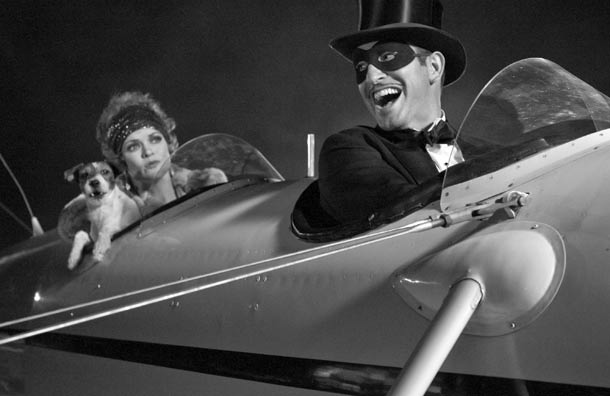The Artist
PGPerhaps it's a backlash against the techno blitz of CGI and 3D technology that so many modern films rely on these days, or merely a healthy curiosity, but there's certainly a veritable buzz surrounding The Artist. After all it's not every day that a silent, black & white film is released.
Director Michel Hazanavicius has produced a remarkable homage to the dawn of cinema, acting as it does as a reminder to the pioneers of film.
It's 1927 and George Valentin (Jean Dujardin) is the screen idol du jour in Hollywoodland. His films are proving to be box office gold as his legions of fans lap up his dapper debonair image. Although his success is undoubtedly his own doing, he does owe some of it, in part, to his regular screen pooch partner. Together however, they make a formidable team.
During one premiere George bumps into a woman in the crowd, an incident the press manage to capture on film. The next day the headline reads "Who's that girl?". As it turns out, her name is Peppy Miller (Bérénice Bejo) and she decides to audition as a dancer in George's next film. Al Zimmer (John Goodman), the head of Kinograph Studios, recognises her from the papers, and isn't happy with her appearance on set. George speaks up for her though, and Peppy gets the part.
For Peppy, the role is the beginning of her star's own ascendency. She's also helped by the fact that her arrival in the business known as show, also collides with the introduction of a new technological advance in cinema: sound.
Although George initially waves this new invention off as a fad, this star of silent cinema soon learns that in his case, actions don't speak louder than words, as his fame begins to fade to black.

Hey doll, I have a confession for you. I don't really know how to fly this thing - isn't that a riot?!!!
There's a cool and refreshing simplicity about The Artist. Hazanavicius, who also wrote the script, could have easily been swept up in the concept of a silent film and delivered an esoteric art house film. Instead, he chooses to stay true to the roots of early Hollywood and produced a film that could happily sit amongst classics made at the time and not look conspicuous. It is joyously accessible and easy to watch.
What it is though, more importantly, is proof that films don't need huge mega-budgets for special effects, or seemingly 'special' stars for that matter. What is still king, clearly, is story. And as this film illustrates, you don't even need words to tell a good story.
For a number of generations, the concept of a silent film is a foreign one. Hell, the concept of a silent audience is too, sadly, thanks to various annoying portable technological devices. But there are still a large number of people who will remember watching Harold Lloyd hanging off of the clock face, as well as early Laurel & Hardy films, as these films were often shown on TV during the summer holidays. And it's to this crowd that this film may resonate and hit a strong note of nostalgia.
It could be said that The Artist is nothing more than a gimmick itself, albeit one it uses to good effect to stand out from the crowd. But there does seem to be somewhat of a trend occurring, what with this and War Horse both relying on simple stories to propel their narratives. Perhaps audiences are becoming jaded with cinema going. Perhaps cutting edge technology isn't necessarily wanted by the masses.
Of course The Artist won't halt the relentless beast that is 3D with all its technological trappings, nor will it call an end to the expensive all-action Hollywood blockbuster. But what it will do is always serve as a nagging reminder that big isn't always clever. And, now and then, you just can't beat a good, well-told story.
